There are fewer than a dozen surviving cellos by Pietro Giacomo Rogeri and this example, dating from circa 1715, is one of his finest. The materials are exceptional: maple with wide, deep and luminous flame, broad-grained spruce with beautiful bear claw figurations, and all over the cello, a dazzling, bright, amber-colored varnish. In addition to its striking appearance, the cello is a player’s dream: powerful and virtuosic, robust yet focused, with myriad subtleties and a complex multi-layered sound.
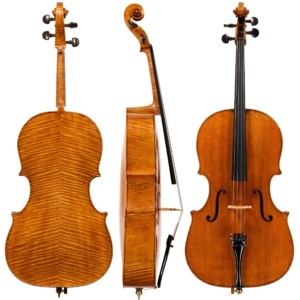
Pietro Giacomo (1665 – 1724) and his father Giovanni Battista (1642 – c 1710) were the two most important makers in the city of Brescia at the turn of the 18th century. Situated just 50 kilometers to the north of Cremona, Brescia had a rich tradition of violin making which dated back to the 16th century. In fact the two cities had once rivaled for dominance but Brescia had suffered a significant setback when Maggini, the leading Brescian maker, died in the plague of the 1630s. In the forty years that followed, violin making in Brescia languished and the tradition stalled. And then in around 1675, Giovanni Battista Rogeri, a Bologna native who trained in the Amati workshop, set up shop in Brescia and thus began a new era of Brescian violin making.
The models that Giovanni Battista and Pietro Giacomo used for their violins and cellos were, for the most part, of Cremonese proportions and although their output varied, the style is closely derived from the Amati tradition. Their instruments are evidently constructed on an internal mold; they are mostly single purfled, moderately arched and are varnished in a blond, golden color. Both father and son referenced Nicolò Amati on their labels, no doubt to emphasize their Cremonese training and connections.
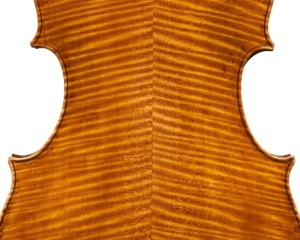
The materials are exceptional. Wide, deep and luminous flame descends from the center joint of the back to the edges
Pietro Giacomo was born in 1665 and evidence suggests that he trained and assisted in the workshop of his father. We don’t know exactly when Giovanni Battista died but it was sometime around 1710. From 1705, Pietro Giacomo had started to use his own label and his independent production continued until his death in 1724.
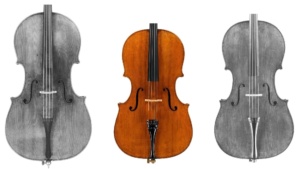
Although nearly the same width as Stradivari’s pre-1700 and forma-b cellos, this P. G. Rogeri (center) is noticeably more manageable in body-length.
The proportions of this cello are highly interesting. The overall body length is modest but the cello is exceptionally wide. When compared to other cellos being made in the rest of Italy in the same period, this Rogeri seems ahead of its time. Stradivari’s pre-1700 cellos were over 78.0 cm long and his iconic forma-b pattern was 75.5 cm. By contrast, this Rogeri measures just 70.5 cm in back-length but is almost just as wide as a forma-b with bout measurements of 34.4 cm and 43.3 cm. The body-stop, the distance from the upper edge to the f-hole notches, is 39.5 cm, just slightly less than that of a forma-b.
In fact, proportionally this cello seems to foreshadow two other important models in the development of the cello: the broad and powerful cellos made by Montagnana in the 1730s and the Turin cellos of G. B. Guadagnini from the 1770s and 80s.
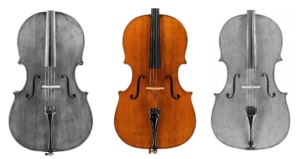
The Rogeri model seems to foreshadow the Montagnana model of the 1730s (left) and the Guadagnini model from Turin in the 1770s (right).
The purfling is narrow with finely dyed blacks and maple whites. It is set close to the edge and terminates in tidy corner miters pointing gracefully to the center of each corner, not inwards towards the center bouts. The locating pins are inset from the purfling and on opposite sides of the center joint (the upper pin has been replaced). In the center of the back on the interior of the cello, there is no trace of a central pin. Although this feature is present in nearly all makers descended from the Amati tradition, the Rogeri family seems at some point to have abandoned the use of the central pin.
It couldn’t have been an easy task to carve the arch and scoop in such strongly flamed maple – even the sharpest gouges create tear-out with maple as deeply flamed as this. In fact the small areas of grain tear-out in the fluting of the back, now filled with varnish and centuries of dirt, resemble the edges of instruments of Gaspar ‘da Salò’ from a century prior.
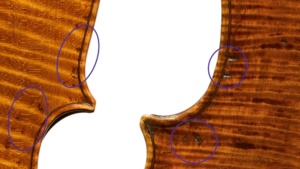
The small dark pits in the fluting – a byproduct of working with deeply flamed maple – recall instruments of Gaspar ‘da Salo’ (right).
Interestingly, the head of this cello is carved on the slab, contrary to the traditional approach. Typically scrolls for violin and cello are cut on the quarter, from wedge shaped slices of the tree. The scroll model is also slightly unusual and lacks the discipline we see in earlier Rogeri cellos. The volute is delicately carved and deeply hollowed into the final turns. A small rounded chamfer ending in an undersized eye is a contrast to the sturdy and almost stocky heads his father was making several decades earlier. In general this head follows the Cremonese standard: the pegbox walls are mostly parallel, the step into the cheeks is at a right angle to the plane of the fingerboard when viewed from the side, the fluting on the rear of the head is shallow and symmetrical and the center-line disappears under the chin.
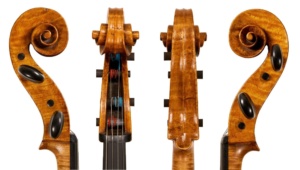
The head is cut on the slab and lacks the discipline and robustness that we see in earlier Rogeri cellos.
This cello bears a label of Giovanni Battista dated 1703 but this is incompatible with the results of a dendrochronology examination which dated the latest rings of the treble and bass sides to 1698 and 1709 respectively. This all but rules out the involvement of Giovanni Battista who died sometime around 1710 and leaves us no doubt that the cello was made by Pietro Giacomo in c. 1715.
It is interesting to note that there is a virtual twin to this cello in the possession of the Pro Canale Foundation in Milan which is dated to 1717. In model and materials these cellos bear an uncanny resemblance and can’t have been made more than a few years apart.
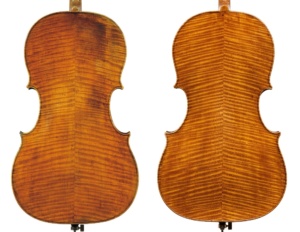
A twin to this cello (left), dated 1717, is owned by the Pro Canale Foundation in Milan.
Pietro Giacomo Rogeri died in 1724 at the age of fifty-nine. It appears that he had no children or followers. With his death, the Brescian tradition once again came to an end.
_____
This Rogeri cello is currently on loan to Italian cellist Erica Piccotti through the Tarisio Trust.